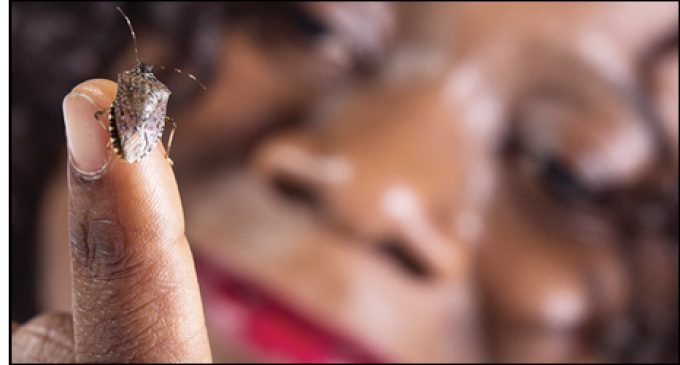A&T researchers tackling stinkbug problem

(pictured above: Dr. Beatrice Dingha examines a brown marmorated stinkbug.)
Entomologists conducting integrated pest management (IPM) research at North Carolina Agricultural and Technical State University have reached a major milestone in studies of the brown marmorated stinkbug.
The voracious bug, which has been identified as the top invasive insect of interest by the U.S. Department of Agriculture, is a major economic threat to fruit and vegetable producers and to many growers of row crops and ornamental plants.
The U.S. Apple Association estimates that in 2010 alone, the bug accounted for $37 million lost from apple orchards in the Mid-Atlantic region, and growers of other crops are reporting similar losses. North Carolina crops that are susceptible to the insect include vegetables, fruits, nuts, berries, corn and soybeans, which together are worth approximately $191 million annually in farm cash receipts. In addition to posing a threat to crops, the bug has also become a common household nuisance, entering homes and other manmade structures to overwinter.
Drs. Beatrice Dingha and Louis Jackai, researchers in N.C. A&T’s Agricultural Research Program, have developed a laboratory rearing method that has successfully produced five generations of brown marmorated stinkbugs. Their work was presented at the annual meeting of the Southeastern Branch of the Entomological Society of America in March, and is believed to be the first reported account of a continuous rearing method for this bug past a second generation in the U.S. The progress represents an important step in establishing a reliable supply of bugs for research.
“Nobody to our knowledge has ever reported this, and as far as we know, this is the first time this insect has successfully been reared through several generations in the laboratory in the U.S.,” Dingha said.
Dingha and Jackai’s method involved feeding the bugs a medley of their favorite foods, including fresh tomato, carrots, green beans, corn, cucumber, squash, and leaves from butterfly bushes and Princess trees. They also kept the bugs at a consistent temperature of 25-27 degrees Celsius (77 – 80.6 degrees Fahrenheit) and 70 percent relative humidity. This combination of factors seemed to encourage the bugs to remain active and reproducing instead of lapsing into their natural dormant state, a form of winter hibernation known to entomologists as “diapause.”
With approximately 100 crops worth $21 billion susceptible to brown marmorated stinkbug damage across the country, the United States Department of Agriculture has an ongoing nationwide research and management program focused exclusively on the insect. Despite some progress, research has been hampered by difficulties in keeping enough bugs alive and reproducing in the laboratory long enough so that controlled experiments can be conducted. Dingha and Jackai say their success means research on the bug can now advance more rapidly.
“If you don’t have a reliable population to work with, you can’t study it and develop management strategies. Now, we are able to do experiments and take research on this pest to the next level,” Dingha said.
Jackai and Dingha’s research is part of the Local Foods and Health Initiative within the School of Agriculture and Environmental Sciences at N.C. A&T. The initiative focuses on research, education and Cooperative Extension outreach programs relevant to small-scale rural and urban growers and consumers in North Carolina who are seeking sustainable agricultural innovations.















